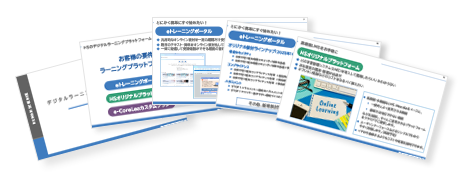2023.08.08
Why is e-learning useful for employee training and development?

In today's rapidly changing business environment, maintaining competitiveness and achieving sustainable growth are critical challenges for companies. To address these challenges, employees with constantly evolving skills and the right knowledge are essential. In other words, it is not an exaggeration to say that "effective employee training holds the key to a company's success."
Therefore, we highly recommend utilizing e-learning for employee training.
E-learning, which leverages the internet and digital technologies to provide learning opportunities, is a learning method that combines effectiveness and efficiency, and is used by many companies.
In this blog, we will provide a comprehensive explanation of various e-learning features that can be used for employee training, including case studies and key points for implementation. We will explore effective ways to utilize e-learning to enhance the results of employee training.
1. Benefits of Employee Training for Companies
As mentioned at the beginning, employee training is essential for companies. Here, we will summarize the benefits that employee training brings to companies.

(1) Adaptation to the Evolution of Technology and Business
The business environment is rapidly changing, with new technologies and business methods emerging one after another. Employee training is essential for companies to respond to the latest technologies and best practices, maintaining their competitiveness. By acquiring the latest skills and knowledge, employees can perform their tasks efficiently, and innovation can also be expected to be promoted.
(2) Strengthening Corporate Competitiveness
As competition among companies intensifies, professionals are required to constantly acquire new skills and knowledge. In other words, employee training can be said to be the foundation for enhancing a company's competitiveness.
Employee training is also about developing human resources that can meet market demands. As a result, it leads to having an advantage over competitors and achieving sustainable growth.
(3) Development of Leadership
Employee training also helps in nurturing potential leaders. Leadership skills are essential not only for managing the organization but also for guiding and developing other employees. By providing leadership training, we can cultivate and strengthen future leaders, contributing to the sustainability and growth of the company.
(4) Improvement of Motivation and Engagement
Employees who receive support for their personal growth through training will become more motivated and dedicated to their work. Additionally, by demonstrating a proactive approach to employee training, companies can enhance employee loyalty and contribute to a decrease in turnover rates.
(5) Promotion of New Ideas and Innovation
Employees who have improved their knowledge and skills through training will develop problem-solving abilities and creativity. This creates opportunities for new ideas to emerge and promotes innovation.
Employee training, which is essential for corporate growth, generates various benefits such as enhancing skills and expertise, developing leadership, and improving motivation. Actively engaging in employee training leads to fully enjoying these benefits.
2. Features of e-learning that can be used for employee training
To implement employee training more effectively and efficiently, it is recommended to utilize e-learning equipped with many features. Here, we will introduce the representative functions and characteristics of e-learning.

■ Easy Management with Learning Management System (LMS)
LMS is the core platform for e-learning, allowing centralized management of learning content delivery, progress tracking, and performance evaluation. It is also easy to track each employee's learning history and progress, and to provide follow-ups and feedback as needed.
■ Customizable Learning Content for Original Teaching Materials
E-learning is provided in electronic data format, making it easy to customize and create original learning content for your company. Therefore, it is particularly useful when incorporating internal rules, procedures, and values into the teaching materials. Various formats of teaching materials can be created, such as videos, presentations, texts, and exercises, allowing you to choose the optimal learning method according to the content.
■ Promote Understanding through Interactive Learning Experiences
In e-learning, it is possible to add interactive elements to the teaching materials. For example, by incorporating simulations, games, quizzes, and animations into the materials, it is expected to stimulate interest in learning and promote understanding.
■ Promoting Communication and Enhancing Learning Motivation
The e-learning platform allows employees to exchange opinions and ask questions about learning through features such as forums, chats, and messages with instructors and among themselves. This promotes communication and knowledge sharing, increasing motivation and persistence in learning.
■ Mobile-Friendly for Effective Time Utilization
Many e-learning platforms are compatible with mobile devices. This means that busy employees can easily access them from smartphones or tablets, allowing them to use their free time, such as during commutes, for learning.
By utilizing features and characteristics of e-learning like this in employee training, we can support the improvement and growth of employees' skills. The introduction of e-learning, which enhances the quality of employee training, could be a very beneficial option for companies.
3. Examples of Using e-Learning for Employee Training
So far, we have explained the significance of employee training and the functions and characteristics of e-learning, but in reality, in what situations is e-learning being utilized? Let's take a look at some corporate use cases.
Case Study 1: Orientation Training for New Employees
E-learning can also be utilized for orientation training aimed at new employees and mid-career hires. By implementing e-learning, employees can acquire the same quality of learning from the very first step. Additionally, by including materials such as the company's history, vision, code of conduct, and basic business rules, employees can more easily resonate with the company's purpose and direction.
Case Study 2: Practical Training for On-Site Employees
For tasks and procedures that are difficult to explain in words, e-learning allows for clear communication through visual information such as videos and motion graphics. This provides on-site employees in industries like food service and healthcare with opportunities to acquire more practical skills. While practical training has traditionally relied on on-the-job training (OJT), there have been concerns about inconsistencies in the level of education. However, with e-learning, which can standardize education, those worries are alleviated.
Case Study 3: Continuous Training Programs
In continuous training programs conducted regularly for employees to refine their skills and update their knowledge, e-learning demonstrates its effectiveness. The e-learning platform makes it easy to update and manage teaching materials, ensuring that the latest information is always available. Additionally, while in-person training requires considerable effort to hold consistently, e-learning can reduce both time and costs.
Case Study 4: Training for External Partners
E-learning provides learning online, free from constraints of location and time. Therefore, it can be efficiently utilized for external partners such as agencies and contractors scattered across the country or around the world, for purposes like familiarizing them with new products and services.
Additionally, if you are dealing with overseas companies, using a multilingual e-learning platform allows you to provide materials in various languages.
Note 1: Caution is required as there may be restrictions on e-learning distribution within the EU.
The case studies we introduced are just a few examples, but e-learning is also highly valued in various employee training settings. With its flexibility and efficiency, e-learning is likely to continue innovating corporate training programs in the future.

4. Key Points for Implementing e-Learning in Employee Training
E-learning is useful for employee training, but what points should be considered when implementing it? Here, we will explain the key points to consider when introducing e-learning.

Point 1: Clearly Define the Purpose of the Materials and the Target Audience
It is important to clarify the purpose of the materials and understand what you want to convey to the employees. Additionally, by understanding the characteristics, intentions, and learning environment of the employees, you can provide more appropriate content.
Point 2: Content Should Be Simple and Easy to Understand
Since e-learning is primarily self-directed, lengthy and drawn-out content can decrease employees' motivation to learn. Aim for a short and well-paced structure, and if it seems like it will be long, consider breaking it into chapters.
If the content is short and focused on a specific theme, it will also improve searchability during review.
Point 3: Add Videos and Interactive Elements
It is also effective to incorporate visually enjoyable video materials and interactive elements that promote understanding of knowledge through quizzes and simulations. By attracting employees' interest, it leads to increased motivation to learn and deeper understanding.
Point 4: Establish Evaluation and Feedback Opportunities
E-learning can also incorporate learning assessment and feedback functions. These features allow for understanding each employee's comprehension and progress, enabling the provision of necessary support. Additionally, by allowing employees to grasp their own performance and progress, it can lead to an increase in motivation.
Point 5: Set an Appropriate Learning Pace
Employee training is important, but it becomes counterproductive if it adds to the workload. To reduce the burden on employees, let's set an appropriate learning pace. It is essential to consider the amount and difficulty of information, ensuring that learning can be done without stress.
Point 6: Consistent Improvement and Updates
The business environment is constantly changing, with new information and technologies emerging continuously. To respond to this trend, e-learning content should be regularly improved and updated. Refreshing the content helps prevent the misdelivery of outdated information and the obsolescence of content, allowing you to provide valuable knowledge to employees.
Point 7: Don't Forget About Multi-Device Considerations
Make sure to consider accessibility so that e-learning can be utilized on different devices. Design it to ensure comfortable learning on various devices such as PCs, smartphones, and tablets.
By paying attention to these points, e-learning can become more engaging and effective. To enhance the results of employee training, it is essential to consider the perspective of the employees using it and provide appropriate considerations.
5. Summary
E-learning is utilized in various employee training programs by many companies.
The background may lie in the characteristics of e-learning, such as flexibility, efficiency, and customizability. The ability to create "optimal learning content" that matches each company and provide an "optimal learning environment" tailored to the needs of each employee is the appeal and greatest strength of e-learning.
To maximize the effectiveness of e-learning, it is very important to implement the correct "instructional design." Human Science supports the creation of instructional design specialized for e-learning and has solved numerous challenges together with our clients.
If you are considering utilizing e-learning for employee training, please contact Human Science. We will propose the optimal educational design tailored to your company.












